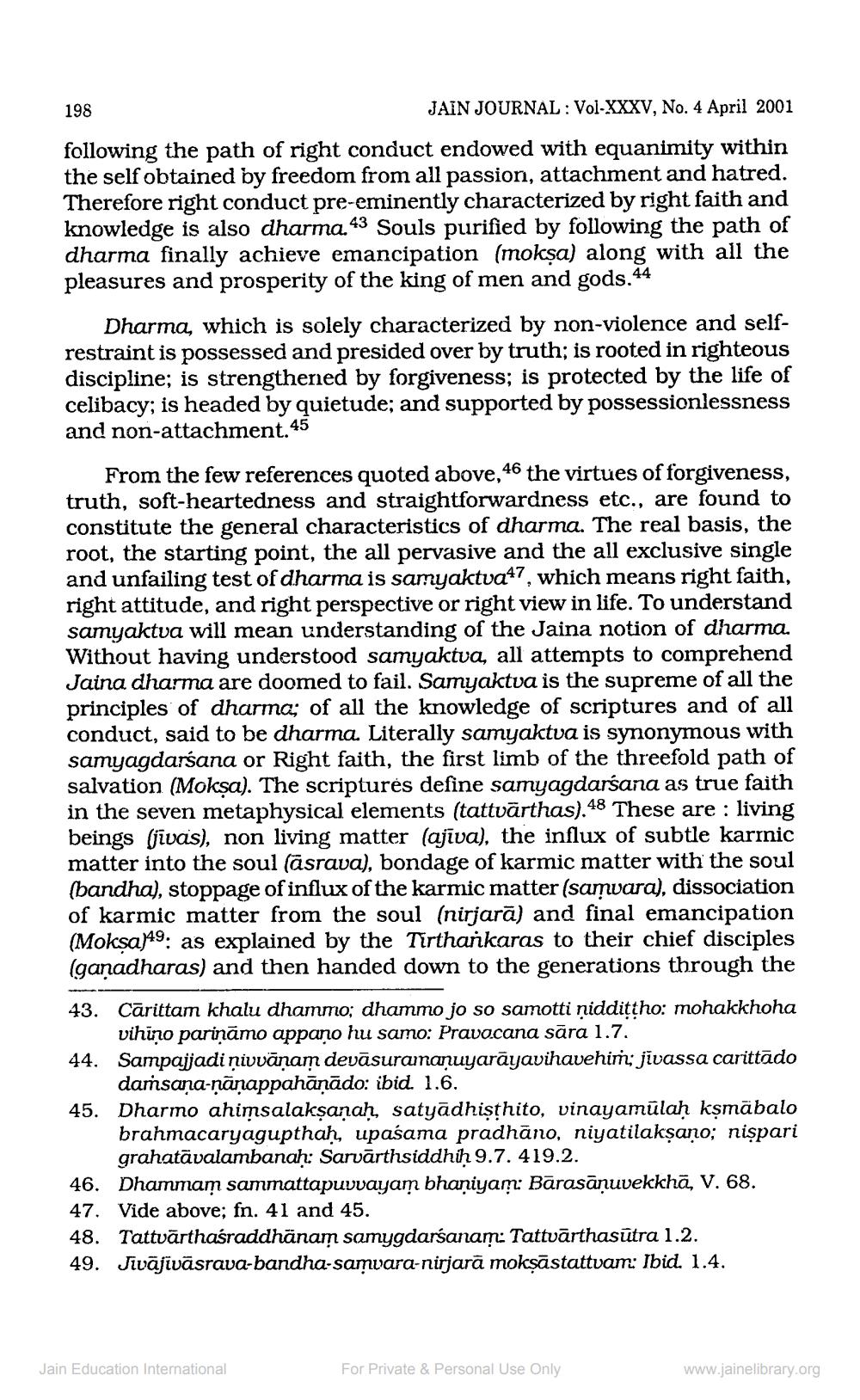________________
198
JAIN JOURNAL : Vol-XXXV, No. 4 April 2001
following the path of right conduct endowed with equanimity within the self obtained by freedom from all passion, attachment and hatred. Therefore right conduct pre-eminently characterized by right faith and knowledge is also dharma. 43 Souls purified by following the path of dharma finally achieve emancipation (moksa) along with all the pleasures and prosperity of the king of men and gods.94
Dharma, which is solely characterized by non-violence and selfrestraint is possessed and presided over by truth; is rooted in righteous discipline; is strengthened by forgiveness; is protected by the life of celibacy; is headed by quietude; and supported by possessionlessness and non-attachment.45
From the few references quoted above, 46 the virtues of forgiveness, truth, soft-heartedness and straightforwardness etc., are found to constitute the general characteristics of dharma. The real basis, the root, the starting point, the all pervasive and the all exclusive single and unfailing test of dharma is samyaktva47, which means right faith, right attitude, and right perspective or right view in life. To understand samyaktua will mean understanding of the Jaina notion of dharma. Without having understood samyaktua, all attempts to comprehend Jaina dharma are doomed to fail. Samyaktva is the supreme of all the principles of dharma: of all the knowledge of scriptures and of all conduct, said to be dharma. Literally samyaktva is synonymous with samyagdarśana or Right faith, the first limb of the threefold path of salvation (Mokşa). The scripturés define samyagdarśana as true faith in the seven metaphysical elements (tattvärthas).48 These are : living beings (jīvas), non living matter (ajīva), the influx of subtle karmnic matter into the soul (asrava), bondage of karmic matter with the soul (bandha), stoppage of influx of the karmic matter (samvara), dissociation of karmic matter from the soul (nirjarā) and final emancipation (Mokşa)49: as explained by the Tirtharkaras to their chief disciples (ganadharas) and then handed down to the generations through the
43. Carittam khalu dhammo; dhammo jo so samotti niddittho: mohakkhoha
vihiņo pariņāmo appano hu samo: Pravocana sāra 1.7. 44. Sampajjadi ņivvānam devāsurannanuyarāyavihavehim; jivassa carittado
damsaņa-ņānappahāņādo: ibid. 1.6. 45. Dharmo ahimsalaksanah, satyādhisthito, vinayamülah ksmäbalo
brahmacaryagupthah, upasama pradhāno, niyatilaksano; nişpari
grahatāvalambanah: Sarvārthsiddhiḥ 9.7. 419.2. 46. Dhammam sammattapuvvayam bhaniyam: Bārasānuvekkhā, V. 68. 47. Vide above; fn. 41 and 45. 48. Tattvärthasraddhanam samygdarśanam: Tattvārthasūtra 1.2. 49. Jivājivāsrava-bandha-samvara-nirjarā moksāstattvam: Ibid. 1.4.
Jain Education International
For Private & Personal Use Only
www.jainelibrary.org




